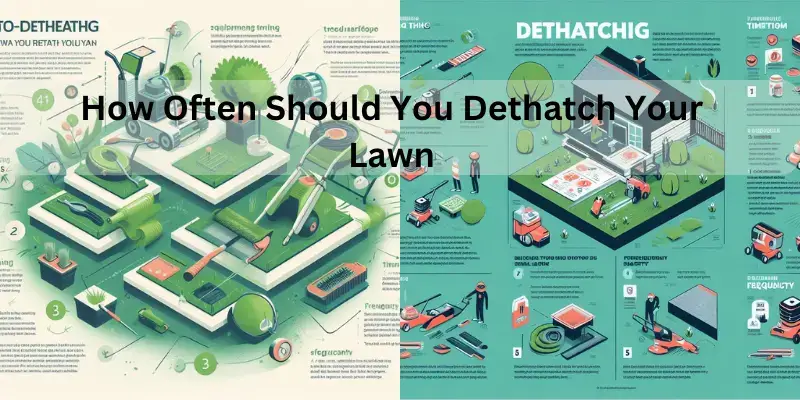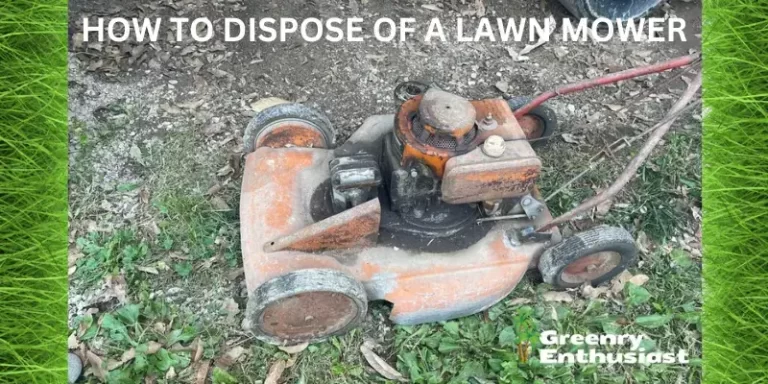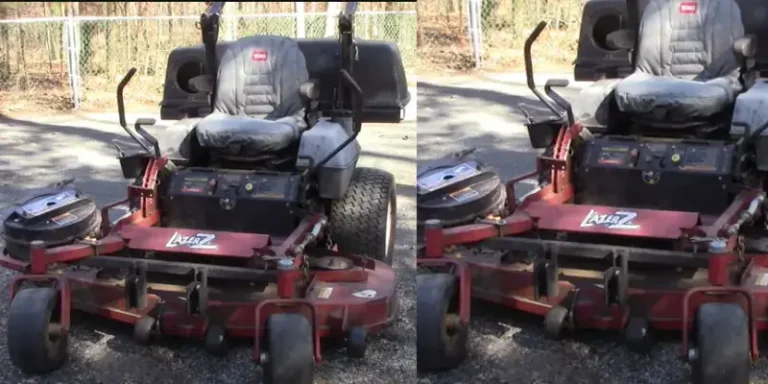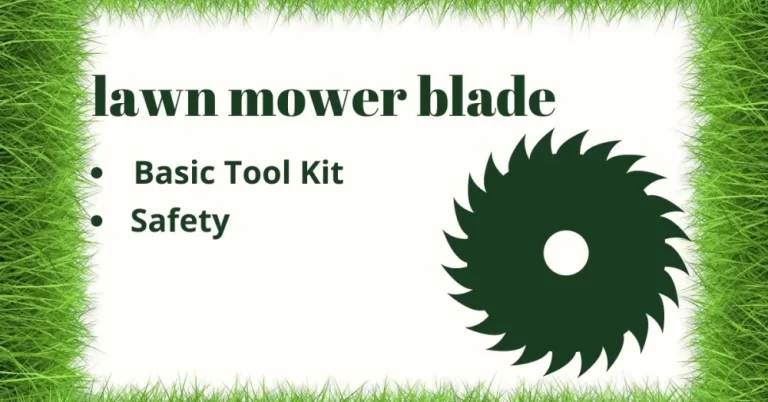How Often Should You Dethatch Your Lawn
A lush, green lawn is a beautiful sight to behold. But did you know that underneath that seemingly perfect carpet of grass lies a hidden problem? It’s called thatch, and it can turn your beautiful lawn into a nightmare if left unattended.
Thatch is the layer of dead grass, leaves, and other organic matter that accumulates on the soil’s surface in your lawn over time. While some thatch is natural and even beneficial, excessive thatch buildup can become a problem. When thatch reaches over half an inch in thickness, it can hinder the overall health of your lawn. It creates a barrier that prevents air, water, and nutrients from penetrating the soil and reaching the grass’s roots, which can lead to a host of issues.
Why Thatch is a Problem for Lawns?
Thatch is a problem for lawns because it’s like a thick blanket of dead stuff on the soil’s surface. This blanket stops air, water, and food from getting to the grassroots, so the grass can’t grow well. It makes the ground feel soft and can give bugs a place to hide. Thatch can also make the grass get sick and not grow strong. So, too much thatch is not good for your lawn.
After reading this a question which arises in every homeowner and professional gardening expert’s mind is “How Often Should You Dethatch Your Lawn”. To answer this Question in detail, I am sharing my gardening expertise with you. Follow me.
Benefits of Dethatching Your Lawn
Dethatching, or removing this layer of thatch, offers several benefits for your lawn:
- Tidying Up: Dethatching helps create a neat and uniform appearance by removing the unsightly layer of thatch that can mar the look of your lawn.
- Nutrient Circulation: It allows nutrients to penetrate the soil, reaching the roots of your grass and promoting healthy growth.
- Pest Control: Dethatching can disrupt the habitat of insects and pests that may hide within the thatch, reducing the risk of infestations.
- Grass Resilience: Dethatching encourages your grass to grow strong, deep roots, making it more resilient to environmental stressors.
- Improved Growth: With better access to nutrients and moisture, your grass can grow more vigorously and lush.
How to Tell if Your Lawn Needs Dethatching
Before you rush to dethatch your lawn, it’s important to determine whether it actually needs it. Here are some signs that your lawn may have an excessive thatch problem:
- Spongy Feel: If your lawn feels soft and spongy when you walk on it, that’s a clear indicator of too much thatch. This softness is due to the insulating layer of dead material.
- Dead Grass Parts: Thatch can smother your grass, leading to patches of dead or brown grass.
- Water Puddles: After a rain or irrigation, if you notice that water puddles on the surface rather than soaking into the soil, it’s a sign that your thatch layer is preventing proper drainage.
- Poor Root Growth: Inspect your grass closely. If you see shallow, weak, or stunted root systems, it’s a sign that your lawn is struggling due to thatch-related issues.
Best Time to Dethatch Your Lawn
When to dethatch your lawn is important. The best time depends on your grass type, as different grasses have different growing seasons. Dethatching during the right season helps your grass recover faster and grow healthier.
Cool-season grasses, such as Kentucky bluegrass, fescue, and ryegrass, grow most actively in spring and fall. So, the best time to dethatch cool-season lawns is during these seasons.
- Early spring: Dethatching when the grass is coming out of winter dormancy helps it recover faster. The cool, mild temperatures and increased moisture during this time create good conditions for your grass to heal and grow vigorously.
- Early fall: Dethatching in early fall is another good option. The cooler temperatures and increased rainfall in the fall provide a comfortable environment for your grass to recover after dethatching. It’s also a good time to prepare your lawn for winter.
- Warm-season grasses, such as Bermuda, zoysia, and St. Augustine grass, have their peak growing season during the warmer months of the year. So, the best time to dethatch warm-season lawns is in late spring or early summer.
- Late spring to early summer: Dethatching warm-season grasses during late spring or early summer takes advantage of the peak growing season. The warmer temperatures and ample sunlight promote faster recovery and robust growth. Be sure to dethatch before the scorching summer heat sets in.
How to Dethatch Your Lawn
Dethatching your lawn is a vital part of lawn care, and there are several methods to do it. Each method has its own pros and cons. Here’s a breakdown of the three most common dethatching methods and step-by-step guides for each:
Dethatching Rake:
A dethatching rake is a manual tool that’s excellent for small lawns with minor thatch problems. It’s cost-effective and eco-friendly. Here’s how to use it:
- Step 1: Mow your lawn to a shorter-than-usual height.
- Step 2: Attach the dethatching rake head if it’s not already on.
- Step 3: Rake the lawn in a systematic manner, working in one direction and then perpendicular to it.
- Step 4: Collect the thatch debris and dispose of it properly.
Power Rake (Dethatcher):
Power rakes are machines designed for larger lawns with thicker thatch. They’re more efficient but might come at a higher cost. Here’s how to use a power rake:
- Step 1: Adjust the power rake’s depth to match the thatch thickness.
- Step 2: Mow your lawn to a shorter height.
- Step 3: Run the power rake over your lawn, moving in a systematic pattern.
- Step 4: Collect and remove the thatch
Vertical Mower (Verticutter):
Vertical mowers are designed for heavy-duty dethatching. They’re ideal for lawns with extensive thatch buildup. Here’s how to use a vertical mower:
- Step 1: Mow your lawn to a shorter height.
- Step 2: Adjust the vertical mower’s depth to the appropriate level.
- Step 3: Run the machine over your lawn, ensuring even coverage.
- Step 4: Remove the thatch debris.
Frequency Guidelines for Dethatching
Dethatching is essential for maintaining a healthy lawn by removing the layer of dead grass and other organic matter that can hinder growth. The right frequency of dethatching depends on the type of grass you have and the climate in your area. Here are some clear recommendations to help you decide when to dethatch your lawn:
Cool-season grasses:
When to Dethatch:
Once a year, ideally in early spring or early fall.
Why This Timing:
Early spring dethatching helps prepare the lawn for vigorous growth, while early fall dethatching allows the grass to recover before the cold sets in.
Examples of Cool-season Grasses:
are Kentucky bluegrass, perennial ryegrass, and fescues.
Warm-season grasses:
When to Dethatch:
Late spring through early summer, during peak growing season.
Why This Timing:
This timing ensures the grass will quickly recover and fill in any bare spots created during dethatching.
Examples of Warm-season Grasses
Bermuda, St. Augustine, zoysia.
Local Climate Considerations:
Adapt to Local Weather:
Check the forecast and choose a mild, stable weather period for dethatching.
Climate Impact:
Weather extremes can affect recovery times, so plan your dethatching when conditions are likely to support rapid lawn recovery.
FAQs About Dethatching
You may have some questions about dethatching your lawn, and we’ve got answers:
- When Not to Dethatch: Avoid dethatching during the hot, dry summer months, as it can stress your grass. Also, if your lawn has a healthy thatch layer of less than half an inch, dethatching may not be necessary.
- Recovery Time: Your lawn should recover within a few weeks after dethatching, depending on factors like weather and the health of your grass.
- Mulching: You can choose to mulch the thatch debris if it’s not too thick. This can return some nutrients to your soil.
Following these guidelines will help ensure your lawn remains healthy, allowing for optimal growth and resilience against diseases and pests.
What to Do? if Lawn Looks Bad after Dethatching?
After Dethatching: Lawn Recovery
After dethatching your lawn, it may look bad initially. This is because dethatching is essentially a deep cleaning for your grass, which can make it appear thin and stressed. There are a few reasons for this initial unpleasant appearance:
- Temporary stress on the grass: The dethatching process can cause some stress to the grass, especially if the thatch layer was thick.
- Exposure to direct sunlight: Once the thatch layer is removed, the grass is more exposed to direct sunlight, which can scorch the blades.
- Compacted soil: The soil beneath the thatch layer may be compacted, which can make it difficult for the grass roots to access water and nutrients.
However, with proper care, your lawn can recover from dethatching and look better than before. Here are some steps you can take to help your lawn recover:
- Water regularly: Water your lawn deeply and regularly, especially in the first few weeks after dethatching. This will help the grass roots to recover and establish themselves in the soil.
- Fertilize: Apply a balanced fertilizer to your lawn a few weeks after dethatching. This will help the grass to grow and thicken.
- Consider overseeding: If your lawn has any bare patches, you can overseed with new grass seed. This will help to fill in the gaps and create a more uniform lawn.
- Aerate: Aerating your lawn can help to improve drainage and reduce soil compaction. This can be done at any time of year, but it is especially beneficial after dethatching.
- Provide shade: If your lawn is exposed to direct sunlight, you can provide some shade by planting trees or shrubs. This will help to protect the grass from sun damage.
- Be patient: It may take a few weeks for your lawn to fully recover from dethatching. Be patient and continue to follow these steps, and your lawn will eventually regain its lush and vibrant appearance.
Recognizing Signs of Trouble
It is important to recognize any signs of trouble during your lawn’s recovery process. Common signs of trouble include:
- Brown or yellow grass: This could be a sign of stress, lack of water, or nutrient deficiency.
- Dead patches: If you see any dead patches on your lawn, overseed them with new grass seed.
- Weeds: Weeds are more likely to germinate in bare patches, so it is important to weed your lawn regularly after dethatching.
To Read more “How to Fix a Lawn Looks Bad After Dethatching“
Frequently Asked Questions
How do I know if my lawn needs dethatching?
Check if the thatch layer is over half an inch thick or if your lawn feels spongy and has brown patches.
Is it good to dethatch your lawn every year?
Annual dethatching is beneficial for lawns with rapid thatch buildup, but not all lawns need it every year.
How long does it take for a lawn to recover after dethatching?
Recovery typically takes a few weeks, but it can vary based on grass type, weather, and post-dethatching care.
How often should you remove thatch from the lawn?
Generally, remove thatch every 2-3 years, but this may vary based on grass type and lawn conditions.
Does dethatching damage grass?
Dethatching can temporarily stress the grass, but it’s beneficial in the long run when done correctly.
Should I cut grass before dethatching?
Mowing to a lower height before dethatching makes the process more effective and manageable.
Should I fertilize after dethatching?
Fertilizing after dethatching helps the lawn recover and encourages healthy growth.
What is the next step after dethatching?
Water the lawn deeply, fertilize, and overseed bare areas to encourage a lush, healthy lawn.
What are the best conditions for dethatching?
During their active growth periods, Dethatch cool-season grasses in early spring or fall and warm-season grasses in late spring.
What are the negatives of dethatching?
Dethatching can temporarily make lawns look bare and stressed; improper timing or technique can harm the grass.
Does dethatching promote growth?
Yes, by removing thatch barriers, dethatching improves soil access, promoting healthier and denser grass growth.
What time of year is best for dethatching?
For cool-season grasses, early spring or fall; for warm-season grasses, late spring, aligning with their growth cycles.
Conclusion
Dethatching your lawn is an important part of lawn care, but it’s important to know when and how often to do it. If your lawn has a thick layer of thatch, it can prevent water, air, and nutrients from reaching the roots of your grass, leading to a host of problems.
The best time to dethatch your lawn depends on the type of grass you have. For cool-season grasses, start in early spring or early fall. For warm-season grasses, late spring to early summer is suitable for dethatching.
There are three main methods of dethatching: dethatching rake, power rake, and vertical mower. The best method for you will depend on the size and condition of your lawn.
After dethatching, your lawn should recover within a few weeks. Be sure to water and fertilize your lawn regularly to help it recover.

About Naveed A Hashmi
In my childhood, I used to see my parents while working in the land, for these reasons today I have been serving the same as our own tradition and culture. I thus love to stay in it, because I want to learn something advanced and new so that I may improve my farm’s contour and help others with my experience.







